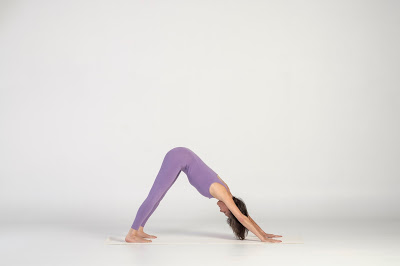by Baxter

I recently got the following short comment on the post Featured Pose: Downward-Facing Dog Pose that we did back on 2015:
“What about shoulders in Adho Muka Svanasana? confused yogi…”
And in reviewing the fairly detailed instructions we had on how to move into, maintain, and move out Downward-Facing Dog pose, I realized that indeed I did not directly address what is happening with the shoulders in this pose. This was partially intentional, as over the years I have received so many different directions for how to work the shoulder blades/upper back/shoulder joint area that it is challenging to distill them down into something that works for everyone. In fact, one of the reasons I don’t actually say much about this in my classes is that there is so much individual variability between people that alignment of the shoulders often has to be individualized if you are going to a try and address this yourself (or for your students, for the teachers out there). Taking that into account, I do still have some basic ways of guiding students when they are doing this pose that work well for many people.
What I personally have found to be most helpful is to stress the work of the arms (rather than the shoulders themselves). I recommend pushing your hands strongly down and forward into the mat, as you might to push a heavy, tall cart forward, while simultaneously pushing your hips up and back on the diagonal line between your wrists and sitting bones. You can have your legs can assist in this backward movement by engaging your leg muscles to create the feeling that they are pulling your hips further back. When those actions take place, your upper back extends into a subtle back bending shape and your shoulder blades naturally spin upwards and widen and firm on the rib cage, which, for the vast majority of my students, is a stable, strong, healthy, and non-painful position. For the anatomy geeks out there, the scapulae (shoulder blades) elevate, protract, and upwardly rotate into position.
To get a feeling of the shoulder blade position in a non-weight bearing position, you can try it in a standing position. From Mountain pose, raise your arms into the classic version of Arms Overhead pose but with your palms facing forward, as they would be for Downward-Facing Dog pose. Lift your arms as high as they can reasonably and comfortably go towards the ceiling and notice the muscles and surrounding tissues around your shoulders that are contracting and/or stretching. Then come down and do Downward-Facing Dog pose with the same intensity of reach—or push in this position—as you did standing and see if you notice similar responses in your shoulders.
The reason I don’t recommend the instruction to move the shoulder blades away from the ears or towards the pelvis is that I find in many people this tends to jam the shoulder joint—or more technically, the gleno-humeral joint—where the arm bone meets the shoulder blade). I also don’t recommend the instruction to widen the shoulder blades because this encourages bending of the elbows (unless it is also accompanied with an instruction to move them into the reach of the arms). See Which Way Should Your Shoulder Blades Go? for information about the natural movement of the shoulder blades when your arms are overhead.
I developed my instructions over the last 20 plus years of practicing, experimenting with, observing, and teaching this intriguing posture. But I know that there are other good teachers out there who have their own takes on this pose, as well. So it is certainly worthwhile to try out different ways of practicing the pose until you find the combination of actions that provide you with stability, strengthening, and stretching in a healthy and beneficial way.
For some other ideas on how to work with the shoulders in Downward-Facing Dog pose, you can check out the following yoga books:
- Light on Yoga, by BKS Iyengar: pg 81-82 of newest addition (note that this version is quite different from my version):
- Moving Toward Balance, by Rodney Yee with Nina Zolotow, pg. 37
- Yoga Anatomy, by Leslie Kaminoff, pgs. 176-7
- Yoga: Awakening the Inner Body, by Donald Moyer, pg. 154
Follow Baxter Bell, MD on YouTube, Facebook, and Instagram. For info on Baxter see baxterbell.com.
Follow Yoga for Healthy Aging on Facebook ° To order Yoga for Healthy Aging: A Guide to Lifelong Well-Being, go to Amazon, Shambhala, Indie Bound or your local bookstore.


I find that part of the "shoulder" question involves how to deal with the rotation of the humerus in the shoulder joint. Internal rotation leads to poor shoulder/scapular stability. I advise external rotation to engage the "lats" and rotator cuff muscles. In Dog ithe cue might be "elbow creases toward ceiling."
If you have not read Judith's take on this in Yoga Body, take a look at the reference I provided in the post-interesting alternative ideas, especially for flexible women.
Thanks for the reference; I will refresh my memory of this!
Are you familiar with Jenni Rawlings? She also does not emphasize pulling the shoulder blades down but instead talks about range of motion.